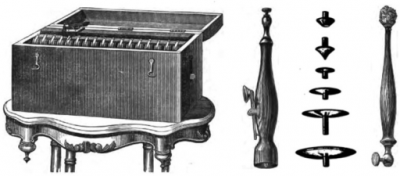ElektrostimulatioN
ElektrostimulatioN
f03: Galvanic Apparatus.From left to right: Emil Stöhrer’s zinc–carbon (or zinc–platinum) battery, universal electrode handle with ivory interrupter, metallic electrodes of various sizes, and sponge electrode with long handle. Stöhrer (1813–1890) was a noted scientific instrument maker, who established a shop in Dresden specifically for electrotherapeutic equipment. Figure source: Beard & Rockwell, 1871.48
Mentions: Galvanic stimulation is a form of electrotherapy that involves the use of direct current applied to specific areas of the body. The “Era of Galvanization” began in 1800 with the invention of the galvanic pile (i.e., the battery) by Italian physicist Alessandro Volta (1745–1827), who was stimulated to pursue this development by his disagreements with Italian physician Luigi Galvani (1737–98) concerning “animal electricity.”48 Shortly thereafter various investigators and quacks applied galvanism indiscriminately,48, 49 but as noted by American neurologists and electrotherapists George Miller Beard (1839–83) and Alphonse David Rockwell (1840–1933) in their monograph, A Practical Treatise on the Medical and Surgical Uses of Electricity (1871), galvanism “failed to fulfil [sic] the extravagant expectations that had been formed of it; a reaction followed, and it fell into disrepute.”48 Electrotherapeutics regained legitimacy in the 1850s with the work of Guillaume-Benjamin-Amand Duchenne de Boulogne (1806–75) in France and Robert Remak (1815–65) in Germany (Figure 2).48,50–52 Thereafter, galvanic, faradic, and combined forms of electrotherapeutics enjoyed wide popularity for various conditions, and were touted in various neurology textbooks in the late 19th century, including Hammond’s A Treatise on Diseases of the Nervous System (1871).3 Examples of the wide range of electrotherapeutic apparatus were also illustrated in textbooks and monographs (Figure 3).3, 48
f03: Galvanic Apparatus.From left to right: Emil Stöhrer’s zinc–carbon (or zinc–platinum) battery, universal electrode handle with ivory interrupter, metallic electrodes of various sizes, and sponge electrode with long handle. Stöhrer (1813–1890) was a noted scientific instrument maker, who established a shop in Dresden specifically for electrotherapeutic equipment. Figure source: Beard & Rockwell, 1871.48
Mentions: Galvanic stimulation is a form of electrotherapy that involves the use of direct current applied to specific areas of the body. The “Era of Galvanization” began in 1800 with the invention of the galvanic pile (i.e., the battery) by Italian physicist Alessandro Volta (1745–1827), who was stimulated to pursue this development by his disagreements with Italian physician Luigi Galvani (1737–98) concerning “animal electricity.”48 Shortly thereafter various investigators and quacks applied galvanism indiscriminately,48, 49 but as noted by American neurologists and electrotherapists George Miller Beard (1839–83) and Alphonse David Rockwell (1840–1933) in their monograph, A Practical Treatise on the Medical and Surgical Uses of Electricity (1871), galvanism “failed to fulfil [sic] the extravagant expectations that had been formed of it; a reaction followed, and it fell into disrepute.”48 Electrotherapeutics regained legitimacy in the 1850s with the work of Guillaume-Benjamin-Amand Duchenne de Boulogne (1806–75) in France and Robert Remak (1815–65) in Germany (Figure 2).48,50–52 Thereafter, galvanic, faradic, and combined forms of electrotherapeutics enjoyed wide popularity for various conditions, and were touted in various neurology textbooks in the late 19th century, including Hammond’s A Treatise on Diseases of the Nervous System (1871).3 Examples of the wide range of electrotherapeutic apparatus were also illustrated in textbooks and monographs (Figure 3).3, 48
Bottom Line: Initial anecdotal reports of success were seldom confirmed with subsequent experience.Several novel invasive therapies were also developed and promoted, all of which damaged or destroyed either upper or lower motor neuron pathways, and were also often associated with high mortality rates.Subsequently, all the invasive procedures employed were directed at lessening or removing the manifestations, rather than the underlying cause, of the abnormal central nervous system "irritation," usually by imposing paresis or paralysis.
